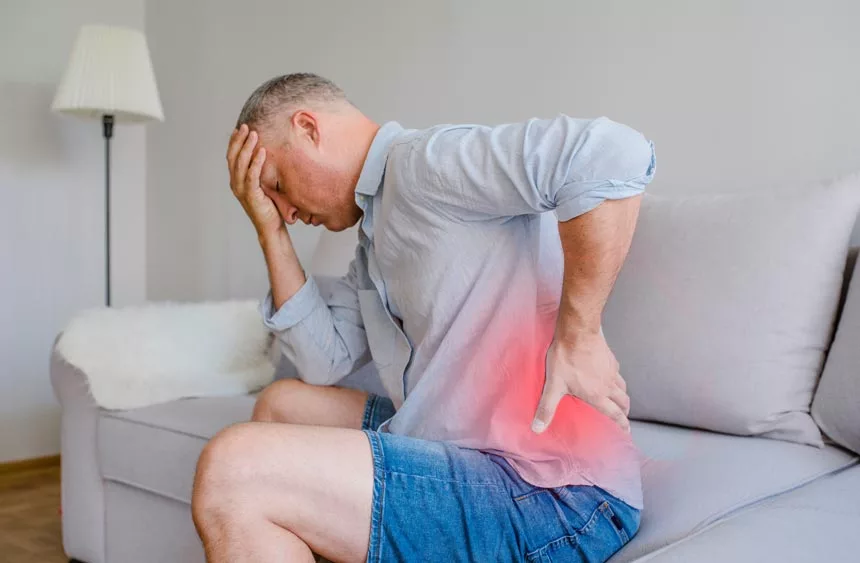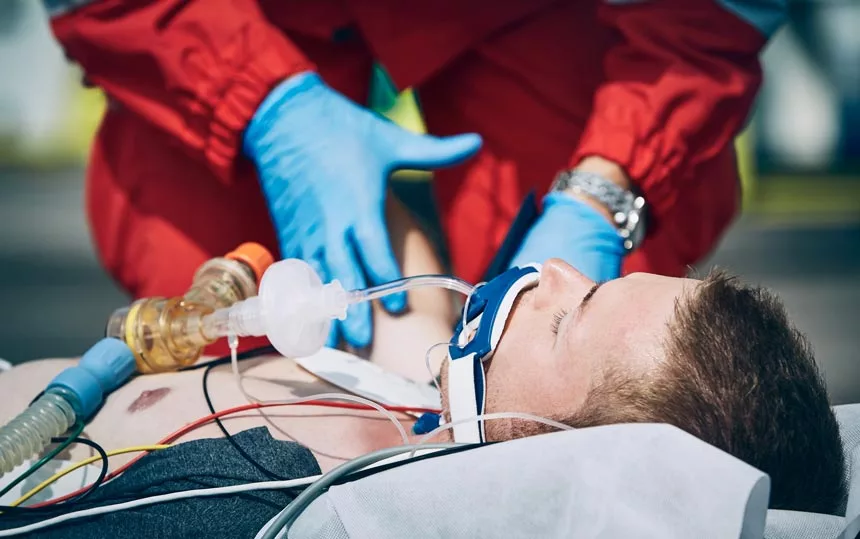What is Cannabis Hyperemesis Syndrome?
Table of Contents
- What is Cannabis Hyperemesis Syndrome?
- How Does Cannabis Use Affect the Body?
- The Difference Between Medical Marijuana and Illicit Cannabis Use
- What Causes Cannabinoid Hyperemesis Syndrome?
- How do I Know if I Have Cannabis Hyperemesis Syndrome?
- Risk Factors for Developing Cannabinoid Hyperemesis Syndrome
- Cannabinoid Hyperemesis Syndrome: Symptoms & Timeline
- Indirect Negative Side Effects of Cannabis Hyperemesis Syndrome
- Can Cannabis Hyperemesis Syndrome be Fatal?
- How is Cannabinoid Hyperemesis Syndrome Diagnosed?
- How is Cannabis Hyperemesis Syndrome Treated?
- Find Cannabinoid Hyperemesis Syndrome Treatment and Get Help With Marijuana Cessation
Cannabis or Cannabinoid Hyperemesis Syndrome (CHS) is a medical condition that causes repeated episodes of persistent and severe nausea and vomiting. While a very rare condition, this can be developed by those who struggle with chronic cannabis abuse.
Chronic marijuana use has become a prevalent issue throughout the nation as, according to current drug abuse reviews, it has become the most commonly abused illicit drug in the US. Out of those who struggle with this form of substance abuse, only a small portion will develop CHS.
How Does Cannabis Use Affect the Body?
Tetrahydrocannabinol (THC) is the main active ingredient found in marijuana. The chemical structure of this psychoactive compound resembles that of the brain chemical anandamide. This similarity causes the body to recognize and absorb THC, in turn altering brain communications.
Cannabis use affects several parts of the brain that are responsible for controlling several cognitive functions, including:
- Pleasure & Reward
- Memory
- Thinking
- Concentration
- Movement
- Coordination
- Sensory & Time Perception
THC attaches to the cannabinoid receptors located in these areas and activates them. This causes disruptions in the central nervous system, reducing its ability to properly function. Two particularly affected areas by this interaction are the hippocampus and orbitofrontal cortex.
These areas of the brain are what allow individuals to form new memories, as well as shift and focus their attention. This is why cannabis users often struggle with learning or taking in new information, or being able to perform tasks and basic motor functions while under the influence.
The Difference Between Medical Marijuana and Illicit Cannabis Use

Despite both recreational and medical cannabis originating from the same marijuana plant and having many similar properties, these two variations can produce quite different effects as a result of how they are manufactured and distributed.
Medical marijuana strains often contain more cannabidiol (CBD), meaning they do not produce the same psychoactive effects an individual will typically experience when using cannabis with higher concentrations of THC.
Recreational marijuana, on the other, generally contains more THC as a ratio to CBD than some medical variants, in turn producing more psychoactive symptoms. Of course, more THC-dominant cannabis products can still be medically used as a way to treat chronic pain.
What Causes Cannabinoid Hyperemesis Syndrome?
Just as there are molecules that bind to THC located within the brain, so too can these be found within the gastrointestinal tract. This means that chronic cannabis can have a negative effect on the digestive tract.
While marijuana can actually help to decrease nausea when active in the brain, it produces the complete opposite effect when processed by the digestive tract.
This can result in long-term marijuana users developing several unpleasant symptoms, including stomach pain, delayed gastric emptying and even persistent nausea and vomiting.
How do I Know if I Have Cannabis Hyperemesis Syndrome?
There are several ways that you can identify whether or not you may have cannabinoid hyperemesis syndrome, the first being if you are ingesting or smoking cannabis chronically and experiencing negative side effects as a result of this behavior.
Additional signs that you are struggling with CHS include:
- Persistent nausea
- Cyclic severe vomiting
- Chronic abdominal pain
- Compulsive bathing
- Weight loss
If you believe that you or a loved one may have CHS, it is important to do a systematic review of your substance use habits and resulting symptoms. Understanding the nature of CHS and your own medical history can be critical in receiving an accurate diagnosis for this condition.
The Connection Between Cannabis Hyperemesis Syndrome and Compulsive Bathing
Individuals with cannabinoid hyperemesis syndrome may find themselves frequently (and even obsessively) taking hot showers, as this has been found to be an effective means of alleviating the nausea and vomiting that comes with this condition.
This may be because of the effect CHS has on the hypothalamic-pituitary-adrenal axis (HPA axis), or the interactions between the brain’s hypothalamus and pituitary gland, and the body’s adrenal glands, which are located on top of the kidneys.
When this system is overstimulated, it can result in abdominal pain, as well as nausea and frequent vomiting. The thermoregulatory nature of hot showers can help reduce this activity, temporarily alleviating some of these more severe symptoms.
Risk Factors for Developing Cannabinoid Hyperemesis Syndrome
The biggest risk factor for developing CHS is chronic cannabis use. This means that someone would have to be engaging in this form of substance abuse at least once a day, over the course of several years in order to develop CHS.
Unfortunately, while not all chronic cannabis users who fit this description will develop this condition, those who do will likely endure severe CHS symptoms, frequent hospitalizations, and persistent, unpredictable interruptions to their normal daily lives.
Cannabinoid Hyperemesis Syndrome: Symptoms & Timeline
For those who have cannabinoid hyperemesis syndrome, these individuals will typically experience CHS symptoms over the course of 3 stages: the prodromal phase, the hyperemetic phase, and the recovery phase.
The Prodromal Phase
During the prodromal phase of cannabinoid hyperemesis syndrome, individuals most commonly experience nausea upon waking up, as well as persistent stomach pain throughout the day. Most individuals may feel an intense need to vomit, but may not actually be able to do so.
As a result, while some individuals in this phase maintain their regular eating habits, some may choose to eat lighter foods or smaller portions due to their nausea. Others may even continue their marijuana use as a way to ease their symptoms; this, however, will only worsen them.
Depending on the person’s habits of substance abuse and whether they decide to seek out medical assistance for their symptoms, this stage of CHS can last over the course of several months or even years.
The Hyperemetic Phase
The hyperemetic phase of cannabinoid hyperemesis syndrome is typically characterized by more severe symptoms than those present in the first stage. These may include:
- Ongoing nausea and vomiting
- Continuing abdominal pain
- Decreased food intake
- Weight loss
- Dehydration
During this phase, the vomiting a person will experience can be extremely intense and difficult to manage. For some, this may even be debilitating, preventing them from being able to carry out their basic day-to-day tasks and responsibilities.
Compulsive bathing will likely start during this stage of CHS, as this can help ease their systems temporarily. Once this no longer proves an effective means of handling their symptoms, most people will finally choose to seek medical care.
When an individual reaches this phase of CHS, their symptoms will typically continue until they become so severe that they are forced to finally make the decision to stop their cannabis use.
The Recovery Phase
Once in the recovery phase of cannabis hyperemesis syndrome, the symptoms associated with this condition will gradually start to diminish. Individuals will find themselves able to start returning to their normal eating habits, as well as function more easily and healthily.
This phase can last over a few days or as long as up to several months, depending on the severity of the person’s cannabis use, as well as their personal health habits. Should someone decide to continue their drug use, these symptoms will likely return.
Indirect Negative Side Effects of Cannabis Hyperemesis Syndrome
There are several additional negative consequences that may occur as a result of prolonged CHS symptoms, particularly the recurring nausea and vomiting this condition causes. These predominantly stem from these symptoms resulting side effects, including:
- Dehydration
- Nutritional Deficiencies
- Aspiration Pneumonia
Dehydration
The extreme nausea and vomiting caused by CHS can quickly cause a person to become dehydrated. This may also result in electrolyte problems in the bloodstream. Both of these issues, if left unaddressed, can cause further complications, such as:
- Muscle spasms or weakness
- Seizures
- Kidney damage or failure
- Abnormal heart rate
- Shock
Because of the severe nature of dehydration and its resulting side effects, it is important to seek out medical assistance from certified healthcare professionals as soon as possible. This can help to prevent irreversible, and potentially life-threatening, damage from occurring.
Nutritional Deficiencies
Cannabis hyperemesis syndrome symptoms tend to cause many individuals to begin eating significantly less, or stick to foods that are low in nutritional value. This can lead to severe weight loss and malnutrition. This, in turn, may cause additional negative side effects such as:
- Hair loss
- Bone pain
- Weakened immune system
- Organ damage
- Stunted growth in younger patients
Aspiration Pneumonia
This type of pneumonia is characterized by an infection in the lungs that is usually caused by inhaling anything other than uncontaminated air, including saliva, food, liquid, vomit and, occasionally, small foreign objects.
While these pneumonic symptoms can be improved with the appropriate medical help, without receiving this treatment, these complications can be quite serious, and may even become fatal. These may include:
- Shortness of breath or wheezing
- Coughing up blood or pus
- Chest pain
- Bad breath
- Respiratory failure
- Extreme fatigue
Can Cannabis Hyperemesis Syndrome be Fatal?

As discussed, several of both the direct and indirect side effects of CHS, without proper treatment, can result in serious complications; including, unfortunately, death. A fatal outcome of CHS can occur due to various reasons, including:
- Kidney failure due to dehydration
- Organ failure to due to malnutrition
- Asphyxiation or infection from pneumonia
How is Cannabinoid Hyperemesis Syndrome Diagnosed?
Because cannabis hyperemesis syndrome is so rare, and so little is known about this condition, it can be difficult to actually receive a diagnosis for CHS. In order for this to occur, your medical provider will likely ask and perform a series of questions and tests.
The first thing that will need to be addressed is your cannabis use. If these habits constitute long-term chronic use of this substance, then further medical toxicology assessments and physical examinations will proceed.
There are several tests your medical provider may conduct in order to rule out any other possible causes for your symptoms, including:
- Blood tests to check for anemia and infection.
- Tests to determine electrolyte levels.
- Pancreas and liver scans or analyses.
- Urine analysis to test for infection, pregnancy or other causing factors stemming from the urinary tract.
- Drug screen, to test for drug or alcohol-related causes of symptoms.
- X-rays of the abdominal area to check for blockages or other complications.
- Upper endoscopy, to check for stomach and esophagus-related causes.
- MRI or CT scan to rule out issues within the central nervous system.
Unfortunately, because of its recent emergence within the medical community, CHS can, for many individuals, go undiagnosed for quite a long time. It may also be confused with a similar condition known as cyclical vomiting disorder.
This is why patient education is a crucial part of receiving an accurate diagnosis for CHS, as many providers may give a false or misinformed health assessment to these individuals due to the limited amount of information available on the causes and symptoms of this condition.
If you think that you or a loved one may have or are at risk of developing CHS due to chronic habits of marijuana use, it is important to seek out both a licensed medical professional and addiction specialist when attempting to get diagnosed and treated for this condition.
What is Cyclic Vomiting Syndrome?
Cyclic, or Cyclical Vomiting Syndrome (CVS) is, like Cannabis Hyperemesis Syndrome, a disorder characterized by sudden and repeated attacks of severe nausea and recurrent vomiting. These episodes can continue for anywhere between a few hours to several days.
This cyclical nausea and vomiting, while similar to the associated symptoms of CHS, differs from this syndrome in the fact that they are not caused by chronic cannabis use.
While not much is understood about the exact cause of CVS, there are some known potential triggers for this condition. Some of these potential risk factors for experiencing an episode of cyclic vomiting may include:
- Severe emotional distress
- Anxiety, panic attacks
- Viral infections
- Intense excitement
- Lack of sleep
- Physical exhaustion
- Extreme temperatures
- Excessive alcohol consumption
- Menstrual periods
- Abdominal migraine (commonly seen in pediatric patients)
How is Cannabis Hyperemesis Syndrome Treated?

While there is not yet a specific cure that has been found for CHS, there are several methods and services available to help alleviate some of its symptoms and help individuals to overcome their substance use.
For those who are experiencing particularly violent repeated vomiting, emergency medical care may be necessary. Once admitted to a hospital’s emergency department, individuals may receive several forms of clinical assistance, including:
- IV fluids to help with dehydration
- Emergency medicine to help ease vomiting
- Pain medication
- Proton-pump inhibitors to help reduce stomach inflammation
- Frequent hot showers
- Prescribed medicines for stress and anxiety relief
There is also pharmacologic treatment available for treating CHS, in the form of a topical capsaicin cream. This can be used by rubbing the capsaicin cream on the stomach area, working to produce the same pain and nausea-relieving effects as taking a hot shower would.
As of right now, the only definitive treatment known to exist for CHS is cannabis cessation. This means that those who have been diagnosed with this condition will need to completely stop using marijuana in order for their symptoms to fully go away.
This recovery process can take anywhere between a few days or several months after a person’s last time using cannabis to complete. In many cases, someone who is overcoming chronic cannabis use will require professional help to maintain abstinence.
For these individuals, seeking out addiction treatment providers and sober support services can play a critical role in their recovery process. This may include participating in various levels of care, including medically supervised weed detox, as well as receiving treatment in an inpatient or outpatient setting.
Mental Health Treatment and Cannabinoid Hyperemesis Syndrome
According to the Substance Abuse and Mental Health Services Administration (SAMSHA), effective addiction treatment should take an integrated approach to the recovery process.
This means incorporating both substance abuse and mental health services into a recovering person’s treatment plan. Integrating both of these services can help these individuals address both their substance use disorder, as well as the underlying causes of these habits.
Someone who is recovering from CHS as a result of their chronic cannabis use can significantly benefit from understanding why they feel the need to abuse marijuana, and learning new coping skills and self-soothing techniques that can help them better maintain abstinence.
Find Cannabinoid Hyperemesis Syndrome Treatment and Get Help With Marijuana Cessation
If you or a loved one is struggling with cannabis hyperemesis syndrome and is unable to stop your chronic marijuana use on your own, know that you are not alone, and help IS available.
At Find Addiction Rehabs, we are dedicated to helping people like you find addiction treatment and sober support services that can provide all of your personal care needs. Our hotline is available 24/7 to provide recovery tools and resources, anytime you need them.
So make the right choice; call us today, and a recovery representative will help you take the first step to achieve sobriety and overcoming your CHS symptoms. Just by picking up the phone, you can get started on your recovery journey, and finally achieve a happier, healthier, CHS-free you!
Nicole R. is an experienced and accomplished writer with special interests in the fields of Anthropology, English, and behavioral health, and has written countless articles for newspaper publications, institutional research journals, and Find Addiction Rehabs.
Her alma matter is Florida Atlantic University in Boca Raton. Nicole hopes to spread awareness of and combat the stigmatization surrounding addiction and substance abuse treatment through her writing and work in the field.


